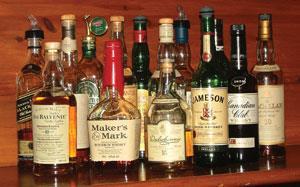Unusual booze faces standardisation
Arthur Rogers/Strasbourg, France
Legislation approved by the European Parliament in June will enhance an intoxicatingly interesting branch of analytical chemistry by introducing legally binding technical standards for around 50 spirit drinks. Detailed rules will cover methods of production and quality standards for the base ingredient, ethanol, including maximum permitted levels of residues of esters, aldehydes and methanol.
What’s your poison?

As a benefit for the unwary, the draft regulation also offers a guide to the European Union drinks cabinet. The botanically savvy will realise the origins of the Rhineland drink Topinambur - the tuber better known in the UK as the Jerusalem artichoke - but they might not realise that materials as diverse as rose petals and holly berries can appear as flavouring in other products. Although Luxembourg’s version of rye whisky will be rarely encountered, visitors to Italy may have sampled nocino, a glutinous, brown firewater made from whole green walnuts. Another Italian speciality, the colourless aniseed-flavoured liqueur mistra, requires caution since the EU rules will allow an alcoholic strength of up to only 47 per cent by volume (the mandatory minimum for mistra is 40 per cent, with a maximum of 47 per cent).
However, for the well-versed imbiber, EU expansion into central and eastern Europe will present new challenges to the palate, if not the liver. There, EU legislation will standardise everything from Lithuanian grain spirits to a bewildering variety of Bulgarian and Romanian spirits with near-pyrotechnical properties.
Foiling the fraudsters
Public analysts who represent, along with trading standards officers, a front line defence against counterfeit products, will have to acquaint themselves with these exotica as they penetrate the UK branch of the EU Single Market. The need for vigilance was indicated in June with the prosecution of two shopkeepers in Burnley, Lancashire, who were selling a counterfeit vodka containing 16 times the legal limit of methanol which, in extreme cases, can lead to blindness or death.
Public analysts are also called upon to confirm brand authenticity, which may involve determination of the ’congener’ profile in the case of whisky. Congeners are produced along with ethanol during the fermentation or ageing processes, and include organic molecules such as polyphenols.
The EU claims it is not standardising for the sake of uniformity but in order to protect appellations and geographical indications (GI) under the terms of World Trade Organisation rules, in particular on trade-related intellectual property rights.
The regulation was approved by the European Parliament after MEPs rejected Polish-led demands that vodka should be produced only from traditional raw materials: potatoes or cereals. Vodka is now produced in various configurations everywhere from the Urals to the US. As an EU compromise, vodkas which use non-traditional raw materials must be labelled as such.






No comments yet